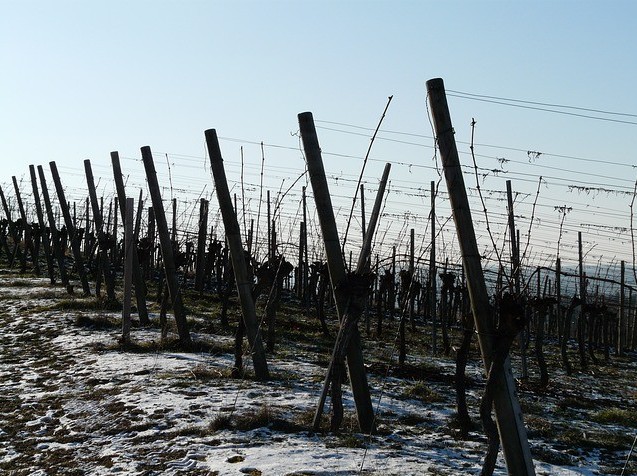The grape vine trellis is used to support the weight of the grapes when they have their full fruit set on. There are three commonly used different types of trellises. The style of trellis used depends on the type of grape that will be grown. American grape species and French American hybrids tend to grow downward, while Vitis vinifera or European grapes grow upward.
Curtain-Style Grape Vine Trellis
The downward growth of American and hybrid grapes is best suited to curtain-style grape vine trellis. These include the high cordon system, which supports the vine on a single wire. The fruiting shoots hang down from this wire-like curtain.
Geneva Double Curtain or VSP Trellises
Another system is the Geneva double curtain which adds a second top wire to the high court on the system. The Geneva double curtain is used for extremely vigorous grape varieties and is not commonly used in the home setting. Vinifera-type grapes, including most of our wine grapes, are often grown with a vertical chute positioning or VSP system. This grape vine trellis system uses a low cordon wire that’s set about three feet above ground level. The plant shoots grow upward from this cordon wire and is woven through a series of horizontal catch wires as they grow toward the top wire. The VSP system is more expensive to install, and it requires continuous training and vine management. So it also is not widely used in the home setting.
Trellises For Backyards
Most backyard grape growers use the high court on the trellis system because it’s the simplest and easiest for maintaining our vines. It consists of line posts that are placed within the grape row. M posts that support the weight of the crop and a wire which we use to train our vines.
How to Build a Grape Vine Trellis 
The first step is to set our end post. Typically the end posts are wooden four-by-four cedar or treated lumber. And we used eight-foot posts, which are placed two and a half feet into the ground giving five and a half feet above earth level. If you’re going to have very long rows, you want to add some extra support to the end posts by anchoring them into the ground. Suppose you’ll be planting more than one row of grapes. You want to space your rows 10 feet apart. The next step is to set our line posts. We typically use T posts and middle T posts for our line posts. You can also use the wooden post. These will be set two and a half feet again in the ground, with five feet extending above the soil surface. The spacing of our line posts is associated with our plant spacing. Outstanding plants are going to be spaced eight feet apart, and we typically put line posts between every third plant.
Ready to Put the Wires
We’re now ready to put on our wires. You have to choose durable galvanized steel wire because the grapevines can be very heavy. I recommended a number nine wire. They need to be attached to your end posts. The best way I found to do this is to use a wire vise device. It’s very inexpensive, but it makes maintenance of your wire over time much more accessible because each spring, you need to tighten your wires. So what you’ve done is pre-drilled a hole through your end post, and you are going to feed the wire through that. We find that it’s easiest to put the vise on after the wires are fed through rather than putting the vise in and trying to feed this wire through the hole. So you have to go ahead and put the wire on. This works because the wire can only feed through the vise in one direction. You can’t pull this back off. You would have to cut it off and pull the wire through. And that helps hold it securely in place.
